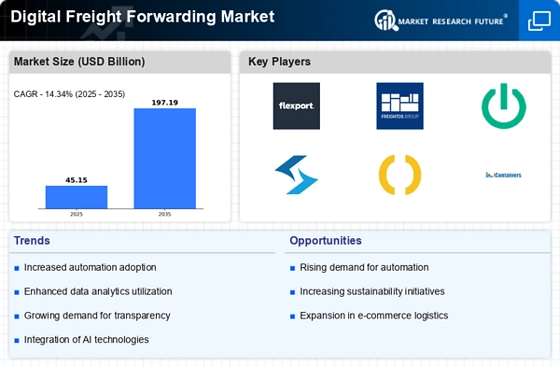Focus on Sustainability
Sustainability initiatives are emerging as a significant driver in the Digital Freight Forwarding Market. Companies are increasingly prioritizing environmentally friendly practices in their logistics operations. Digital freight forwarding solutions can optimize routes and reduce carbon footprints, aligning with corporate sustainability goals. Recent data indicates that logistics companies adopting green practices can enhance their brand reputation and customer loyalty. As consumers become more environmentally conscious, the demand for sustainable logistics solutions is expected to rise, further propelling the growth of the Digital Freight Forwarding Market.
Growing E-commerce Sector
The Digital Freight Forwarding Market is significantly influenced by the burgeoning e-commerce sector. As online shopping continues to gain traction, the demand for efficient freight forwarding solutions has escalated. E-commerce businesses require rapid and reliable shipping options to meet customer expectations. Data indicates that the e-commerce logistics market is expected to reach a valuation of over 500 billion dollars by 2026. This growth necessitates advanced digital freight forwarding services that can handle increased shipment volumes and provide seamless integration with various platforms, thereby driving the Digital Freight Forwarding Market forward.
Demand for Cost Efficiency
Cost efficiency remains a critical driver in the Digital Freight Forwarding Market. Companies are increasingly seeking ways to minimize logistics expenses while maintaining service quality. Digital freight forwarding solutions offer competitive pricing models and optimized routing, which can lead to substantial savings. Recent studies suggest that businesses utilizing digital freight forwarding services can reduce their logistics costs by up to 20 percent. This focus on cost reduction is compelling organizations to adopt digital solutions, thereby propelling the growth of the Digital Freight Forwarding Market.
Regulatory Compliance and Standards
The Digital Freight Forwarding Market is also shaped by the need for regulatory compliance and adherence to international standards. As trade regulations become more stringent, companies must ensure that their logistics operations meet various legal requirements. Digital freight forwarding platforms often incorporate compliance features that simplify the documentation process and ensure adherence to customs regulations. This capability is particularly vital in regions with complex trade laws. The increasing emphasis on compliance is likely to drive the adoption of digital solutions within the Digital Freight Forwarding Market.
Technological Advancements in Logistics
The Digital Freight Forwarding Market is experiencing a surge in technological advancements that enhance operational efficiency. Innovations such as artificial intelligence, machine learning, and blockchain are transforming traditional logistics processes. These technologies facilitate real-time tracking, predictive analytics, and automated documentation, which streamline operations and reduce costs. According to recent data, the adoption of AI in logistics is projected to grow at a compound annual growth rate of over 40 percent in the coming years. This rapid technological evolution not only improves service delivery but also enhances customer satisfaction, making it a pivotal driver in the Digital Freight Forwarding Market.
















Leave a Comment